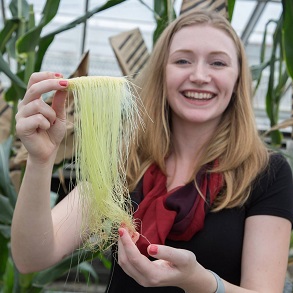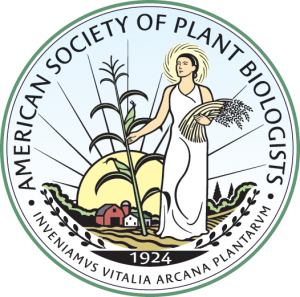Plantae Presents: Florian Busch and Katie Murphy
Due to the COVID-19 pandemic many seminar series and conferences have been canceled or postponed. In response to this, and to make sure plant scientists can continue to communicate their latest work to their peers, The American Society of Plant Biologists launched a virtual seminar series via our online community, Plantae. This is the 8th seminar in this new series, each of which features two speakers (read more). A list of upcoming seminars and recorded videos can be found here.
 Florian Busch: Carbon isotope discrimination in C3 plants: Assessing CO2 diffusion inside the leaf mesophyll
Florian Busch: Carbon isotope discrimination in C3 plants: Assessing CO2 diffusion inside the leaf mesophyll
Florian Busch is a Research Fellow at The Australian National University. He obtained his PhD from the Heinrich-Heine University in Düsseldorf, Germany, during which time he worked closely with Norm Hüner at Western University in London, Canada. After several years of post-doc work with Rowan Sage at the University of Toronto, Canada, and Susanne von Caemmerer at The Australian National University, he moved on to his current position working with Graham Farquhar. He will start his own group at the School of Biosciences at the University of Birmingham, UK, later this year. Florian is a theoretical and experimental plant physiologist interested in all aspects of photosynthesis. His focus is on linking different photosynthetic processes with mathematical models to study the biochemical limitations of carbon fixation and to gain a quantitative understanding of how plant carbon uptake responds to changes in their environment. @FlorianABusch
 Katie Murphy: Terpenoids in maize: from biosynthesis to bioactivity
Katie Murphy: Terpenoids in maize: from biosynthesis to bioactivity
Katie Murphy is a Ph.D. Candidate in the Zerbe Lab at the University of California, Davis. Her research focuses on diterpenoid biosynthesis in maize and how these molecules relate to the plant stress response. She holds a B.S. in chemistry from Stanford University, where she studied anther development in maize with Dr. Virginia Walbot. Katie is the Early Career Representative to the ASPB Women in Plant Biology Committee and is an ASPB Ambassador. She recently won the UC Grad Slam for the best short presentation of her research. @GMOhmygod
Additional Q&A with Katie Murphy
- What specific role do dolabralexins play in maize in addition to these stresses as all plants get affected by biotic and abiotic stresses?
- So far we have shown roles in biotic and abiotic stress, and you can hear about their role in determining the rhizosphere microbiome at my talk at Plant Biology 2020 Virtual summit. There are other stressors (herbivores, UV, etc.) that we are interested in exploring, as well.
- Can you provide dolabralexins exogenously and complement the phenotypes of Zman2 mutants?
- We cannot yet make or purify enough dolabralexins to apply them exogenously to maize plants to complement the mutant phenotype, but that’s something we are working towards in the future as we increase our heterologous production systems.
- Are the dolabralexins secreted to apoplast in roots?
- We have preliminary evidence that dolabralexins are secreted from maize roots into the rhizosphere and are following up with more experiments.
- Question for the speaker: Do overexpressor of the enzymes that produce defense metabolites have problems with growth?
- So far, we do not have overexpression lines of any parts of this pathway in maize. Work from another lab has generated an overexpression line of a maize enzyme in rice and shown it to be more resistant to disease without other growth complications (under the conditions they tested). You can read about it here: Shen, Qinqin, et al. “CYP71Z18 overexpression confers elevated blast resistance in transgenic rice.” Plant molecular biology 100.6 (2019): 579-589.
- Do you think dolabralexins have an effect on all fungi or just specific fungal groups?
- So far, we have only tested Fusarium species, although we do see susceptibility across different species. In the future, we hope to test other fungal species as well.
- Are dolabralexins also presented in the wild relatives of maize (teosinte)?
- We have not yet looked into maize wild relatives, but do see the genes encoding the biosynthetic enzymes in the teosinte genomes that are available. The kauralexins have been shown in many zea species, you can find more info here: Ding, Yezhang, et al. “Multiple genes recruited from hormone pathways partition maize diterpenoid defenses.” Nature plants 5.10 (2019): 1043-1056.
- You show mutant plants that reduce all classes of non-gibberelin diterpenoids. How can you be sure that the observed phenotypes are because of dolabralexins?
- With the Zman2 mutant showed we cannot be sure that the observed phenotype is due to dolabralexins and not also kauralexins, or other changes in metabolism. Our current work is on mutants downstream in these pathways to isolate the metabolite groups, and we evaluate the transcriptomic and metabolomic data to identify other potential changes in the mutants. We use other lines of evidence – such as induction under stress conditions and function in vitro – to support evidence for the roles of these specific molecules.
- Do we know the mechanism of Dolabralexin antifungal activity?
- We do not yet know the mechanism of dolabralexin antifungal activity but are actively exploring this.
- Do you know about the transcriptional regulation of genes of these novel metabolites?
- We don’t yet know about the transcriptional regulation of these biosynthetic genes, but we think this is an interesting research avenue to explore.
- So, these molecules have an antibiosis effect of fungi, but it does not completely stop its growth, do you know if these molecules have been tested with FOC R4, which is a major banana problem nowadays?
- So far we have tested select fusarium species, but have not tested FOC R4, although this would be very interesting because it is such a major issue for banana.
- Is this dolabralexin reported in dicot crop for example in Soybean?
- Dolabralexins have only been found in maize, not in any other monocot or dicot species.
- In the case of QPM varieties, any terpenoid compound activities noticed???
- We have not tested any QPM (quality protein maize) varieties, but are interested in diversity across maize lines for the production of these metabolites.
This webinar is freely available thanks to the support of the American Society of Plant Biologists. Join Today.

If you would like to sponsor an upcoming webinar please contact [email protected]
Have additional questions? Let us know in the comments below!
- We have not tested any QPM (quality protein maize) varieties, but are interested in diversity across maize lines for the production of these metabolites.





Leave a Reply
Want to join the discussion?Feel free to contribute!